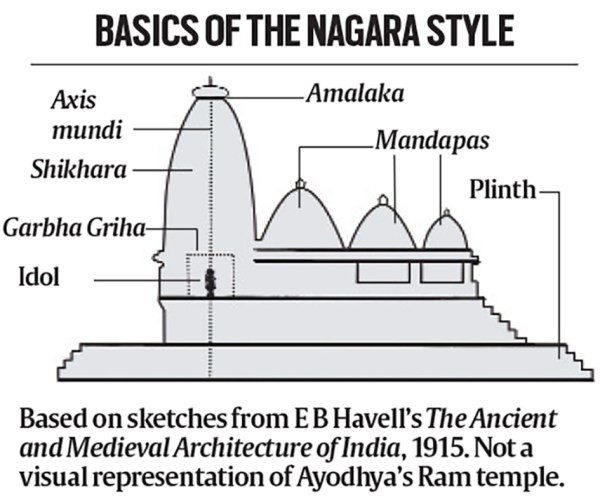Description

Disclaimer: Copyright infringement not intended.
Context
The Nagara style of temple architecture, in which Ayodhya's Ram temple is being built, is a significant tradition with its roots in northern India.
Details
- Emergence: Nagara style emerged around the fifth century CE during the late Gupta period in northern India.
- Architects of Ayodhya's Ram Temple: Chandrakant Sompura and his son Ashish designed the Ram temple complex in the Nagara style.
Architectural Language
- Debated Terminology: The term 'style' is debated, with some scholars, like Adam Hardy, referring to Nagara and Dravida as "the two great classical languages of Indian temple architecture."
- Languages as Systems: Instead of styles, they are considered as architectural languages, providing a vocabulary and grammar for temple construction.
Distinctive Features of Nagara Style
- Shikhara (Tower):
- Towering Structure: Nagara temples have a raised plinth with a towering shikhara, representing a mountain peak.
- Cosmological Symbolism: Shikharas symbolize the natural and cosmological order, such as Mount Meru in Hindu tradition.
- Garbhagriha (Sanctum):
- Sacred Inner Sanctum: The garbha griha is the most sacred part of the temple, housing the deity's idol.
- Mandapa (Hall):
- Pillared Halls: Temples often include one or more mandapas (halls) with pillars.

Five Modes of Nagara Architecture:
- Valabhi and Phamsana: Associated with Early Nagara Style, influenced by wooden structures.
- Latina: A single, slightly curved tower, emerged in the Gupta heartland and spread across northern India.
- Shekhari: Features attached sub-spires or spirelets echoing the main shape.
- Bhumija: Has miniature spires in horizontal and vertical rows, creating a grid-like effect.
- Composite Latinas: Emerged from the tenth century onwards, giving rise to Shekhari and Bhumija styles.
Comparison with Dravida Style
- Vimana vs. Shikhara: In Dravida style, the counterpart to the shikhara is the vimana, typically smaller than gopurams.
- Gopurams: Dravida style features distinctive gatehouses or gopurams, while Nagara style lacks prominent boundary walls.
Hybrid Features of Ayodhya's Ram Temple
- Innovations: The Ram temple in Ayodhya incorporates some hybrid features, like a 732m long wall, even though a traditional gopuram isn't built due to space constraints.

Conclusion
In essence, the Nagara style is characterized by its towering shikhara, symbolic elements, and variations in architecture across different periods and regions. The Ayodhya Ram temple showcases the continuation and adaptation of this rich tradition.
|
PRACTICE QUESTION
Q. What are the commonalities and differences between North Indian and South Indian temples? Make a diagram to supplement your answer. (250 Words)
|
















